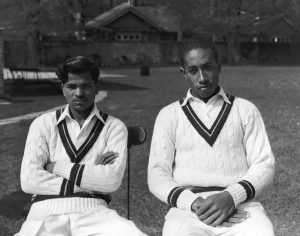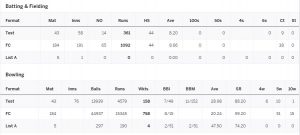
‘Slow bowling prince’ Sonny Ramadhin turns 92
By Reza Abasali of Trinidad and Tobago
“The prince of slow bowlers”
To appreciate this royal description of Sonny Ramadhin by Sir Len Hutton, one must understand the background of Len Hutton.
Sir Len (1916-1990) was one of the greatest ever batsmen in international cricket. Between 1937 to 1955, he played 79 Tests, amassed 6,971 runs with 19 hundreds at an average of 56.7 per innings.
He scored over 40,000 First-Class runs and hit 129 centuries. Hutton first encountered the wily spinner from Trinidad on the West Indies tour of England in the summer of 1950.

Ramadhin became the first cricketer of East Indian descent to represent the West Indies in Test cricket when he made his debut on June 8, 1950, versus England at Old Trafford, Manchester.
The West Indies lost the first Test at Manchester by 202 runs. Sonny was unsure whether he would be selected for the second Test at Lord’s cricket ground on June 24, 1950, after an average performance in the first Test.
He gained the nod, and it was this Test at Lord’s that the then 21-year-old announced himself on the world cricket stage.
In partnership with the crafty 20-year-old Jamaican left-arm-spinner Alfred Valentine (7-127 in the match), Sonny captured match figures of 11-152 to catapult West Indies to their first-ever victory on English soil.
That West Indies team included the three great Barbadian cricketers, Worrell, Weekes and Walcott – famously known as the 3Ws.
The 326-run victory sparked off massive West Indian celebrations on the famous ground. Trinidadian calypsonians Lord Kitchener and Lord Beginner glorified the two spinners in song with their rendition of “Victory Calypso.”
Amidst the huge celebrations and popping of vintage bottles of liquor in the dressing room, his close friend Ralph Narine (1922-2017), who was studying law in England at that time, picked up Sonny and the new hero celebrated elsewhere with ginger beer and curry.

Born in St. Charles Village, near the city of San Fernando on May 1, 1929, Sonny Ramadhin was the son of East Indian sugar workers. His parents, who were born in Trinidad, died when he was still a boy.
A grandparent was born in India. He and his elder brother Ramsamooj went to live with his father’s uncle, Soodhai Rock, and Aunt Sumintra in the nearby village of Esperance, two miles south of San Fernando.
Young Sonny played his cricket with a bat made from a coconut branch and a rubber ball squeezed from a rubber tree. He once told his uncle that he would make a living playing cricket.

He left school at 16 and got to practice at the local Palmiste Club, located on the Palmiste agricultural estate near to his home village of Esperance.
Sonny hardly got to bat, so he started to bowl. In my interview with him from his home in North West, England, last October, Sonny disclosed that he naturally turned the ball both ways with the same action at a young age.
He added that a man called “Yo Yo” used to place coins on the stumps to encourage him to bowl wicket to wicket. A Barbadian-born inter-colonial cricketer by the name of Clarence Skinner (1900-1969), who worked for the oil company, Trinidad Leaseholds Limited, discovered his fledging skill and talent.
Skinner got a job for Sonny at the oil company and he was selected to play for Leaseholds. Skinner pushed the gifted spinner through the ranks of local club cricket at the youth and senior levels.
His performances were certainly noticed by cricket aficionados, which enabled him to be selected to two trial matches versus Jamaica (his friend Valentine was also selected for the two trials) in early 1950 to pick the squad to tour England in April/May 1950.
In the trial matches, he captured 12 wickets at 19.25 runs per wicket.
The West Indies captain Barbadian John Goddard (1919-1987) witnessed one of the trial matches and was impressed by Sonny’s exploits.
The rest was history – the orphaned boy, who bowled with his cap on and sleeves buttoned down, was on the 1950 boat (5.5 Golfito) to England.
Sonny Ramadhin, recipient of the Humming Bird Medal in 1972 by the Government of Trinidad and Tobago, became the oldest living West Indian Test cricketer in July 2020 when Sir Everton Weekes died at the age of 95.
- The writer Reza Abasali is a West Indies cricket historian from El Socorro, Trinidad. He is passionate about the game, especially West Indies cricket.






